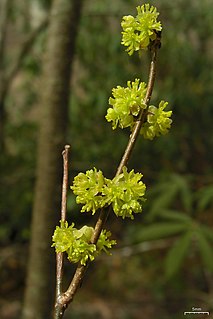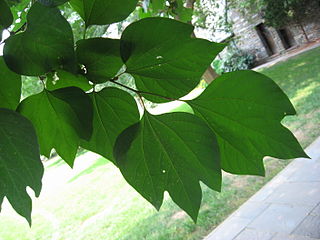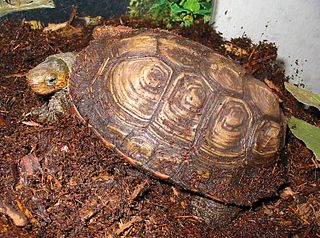
The poinsettia is a commercially important plant species of the diverse spurge family (Euphorbiaceae). Indigenous to Mexico and Central America, the poinsettia was first described by Europeans in 1834. It is particularly well known for its red and green foliage and is widely used in Christmas floral displays. It derives its common English name from Joel Roberts Poinsett, the first United States Minister to Mexico, who is credited with introducing the plant to the US in the 1820s. Poinsettias are shrubs or small trees, with heights of 0.6–4 m (2.0–13.1 ft). Though often stated to be highly toxic, the poinsettia is not dangerous to pets or children. Exposure to the plant, even consumption, most often results in no effect, though it can cause nausea, vomiting, or diarrhea.

Lindera benzoin is a shrub in the laurel family, native to eastern North America, ranging from Maine and New York to Ontario in the north, and to Kansas, Texas, and northern Florida in the center and south. Within its native range it is a relatively common plant where it grows in the understory in moist, rich woods, especially those with exposed limestone.

Caesalpinia pulcherrima is a species of flowering plant in the pea family Fabaceae, native to the tropics and subtropics of the Americas. It could be native to the West Indies, but its exact origin is unknown due to widespread cultivation. Common names for this species include poinciana, peacock flower, red bird of paradise, Mexican bird of paradise, dwarf poinciana, pride of Barbados, flos pavonis, and flamboyant-de-jardin. The Hawaiian name for this plant is ʻohai aliʻi.

Lindera is a genus of about 80–100 species of flowering plants in the family Lauraceae, mostly native to eastern Asia but with three species in eastern North America. The species are shrubs and small trees; common names include spicewood, spicebush, and Benjamin bush.

Lindera obtusiloba, the blunt-lobed spice bush, is a species of flowering plant in the laurel family Lauraceae, native to China, Korea and Japan. It is a spreading deciduous shrub or small tree growing to 6 m (20 ft) tall and wide, with glossy aromatic leaves and deep yellow flowers which appear in spring before the leaves. Juvenile leaves are lobed and are deep purple. The leaves often turn yellow in autumn.

The emerald green snail, green tree snail, or Manus green tree snail, scientific name Papustyla pulcherrima, sometimes listed as Papuina pulcherrima, is a species of large, air-breathing tree snail, a terrestrial pulmonate gastropod mollusk in the family Camaenidae.
Ipomoea pulcherrima is a species of plant in the family Convolvulaceae. It is endemic to Peru.

Lindera melissifolia, common name pondberry or southern spicebush, is a stoloniferous, deciduous, aromatic shrub in the laurel family. This endangered species is native to the southeastern United States, and its demise is associated with habitat loss from extensive drainage of wetlands for agriculture and forestry. Restoration efforts are currently being conducted.

Dihydrochalcone (DHC) is the organic compound with the formula C6H5C(O)(CH2)2C6H5. It is the reduced derivative of chalcone (C6H5C(O)(CH)2C6H5). It is white solid that is soluble in many organic solvents. Dihydrochalcone per se is often minor significance, but some derivatives occur in nature and have attracted attention as drugs.

Lindera aggregata is a plant species belonging to the genus Lindera.

Boldine is an alkaloid of the aporphine class that can be found in the boldo tree and in Lindera aggregata.

Reticuline is a chemical compound found in a variety of plants including Lindera aggregata, Annona squamosa, and Ocotea fasciculata. It is based on the benzylisoquinoline structure.

The ornate or painted wood turtle is one of nine turtle species of the genus Rhinoclemmys of the family Geoemydidae. There are four recognized subspecies.

Lindera is a monotypic moth genus in the family Tineidae described by Blanchard in 1854. Its only species, Lindera tessellatella, was described by the same author two years earlier. It is a widely distributed species, which was first described from South America, but has been recorded from Africa, Europe, North America, Australia, New Zealand, Fiji and Hawaii.
Lindera lucida is a species of flowering plant in the family Lauraceae. It is found in Malaysia.

Dihydrokanakugiol is a dihydrochalcone isolated from Lindera lucida.

Alnetin is a flavone isolated from Lindera lucida.

Dicentrine is an aporphinic alkaloid found in several plant species, mainly from family Lauraceae, including Lindera megaphylla. At high doses, dicentrine shows antinociceptive activity in a mouse model of pain. It probably acts via a TRPA1-dependent mechanism.

Pluviatilol is lignan. It is a Lindera obtusiloba isolate with anti-allergic activity.

Lindera subcoriacea, the bog spicebush, is a plant species native to the southeastern United States from Louisiana to Virginia. It is a shrub that can reach up to 4 m in height. Leaves are broadly elliptic, up to 8 cm long, and faintly aromatic when young. Flowers are yellow. Fruits are ellipsoid, deep red, about 10 mm long. It grows in acidic freshwater swamp forests in the Coastal Plain and Piedmont regions. In the northern portion of its range in the Carolinas and Virginia, L. subcoriacea is found only in the specialized stream pocosin habitat, while in the southern portion from Georgia onwards, it is found only in the wettest portions of the sphagnum bog habitat. As it is specialized and restricted to both of these very rare and unique ecosystems, L. subcoriacea is endangered due to habitat destruction and fire suppression. Only around 100 sites are known across this species' range to still sustain it, and most of these have only 1-5 genetically distinct individuals.


















